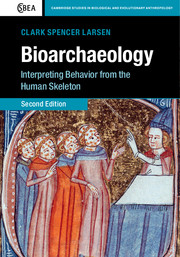Book contents
- Frontmatter
- Dedication
- Contents
- Preface to the Second Edition
- Preface to the First Edition
- 1 Introduction
- 2 Stress and deprivation during growth and development and adulthood
- 3 Exposure to infectious pathogens
- 4 Injury and violence
- 5 Activity patterns: 1. Articular degenerative conditions and musculoskeletal modifications
- 6 Activity patterns: 2. Structural adaptation
- 7 Masticatory and nonmasticatory functions: craniofacial adaptation to mechanical loading
- 8 Isotopic and elemental signatures of diet, nutrition, and life history
- 9 Biological distance and historical dimensions of skeletal variation
- 10 Bioarchaeological paleodemography: interpreting age-at-death structures
- 11 Bioarchaeology: skeletons in context
- References
- Index
- Plate section
Preface to the Second Edition
Published online by Cambridge University Press: 05 April 2015
- Frontmatter
- Dedication
- Contents
- Preface to the Second Edition
- Preface to the First Edition
- 1 Introduction
- 2 Stress and deprivation during growth and development and adulthood
- 3 Exposure to infectious pathogens
- 4 Injury and violence
- 5 Activity patterns: 1. Articular degenerative conditions and musculoskeletal modifications
- 6 Activity patterns: 2. Structural adaptation
- 7 Masticatory and nonmasticatory functions: craniofacial adaptation to mechanical loading
- 8 Isotopic and elemental signatures of diet, nutrition, and life history
- 9 Biological distance and historical dimensions of skeletal variation
- 10 Bioarchaeological paleodemography: interpreting age-at-death structures
- 11 Bioarchaeology: skeletons in context
- References
- Index
- Plate section
Summary
It has been more than 15 years since the publication of the first edition of Bioarchaeology: Interpreting Behavior from the Human Skeleton. The response following its publication in 1997 was overwhelmingly positive – in reviews and comments to me from virtually every corner of the globe. I credit Robert Benfer for convincing me that a synthesis paper I wrote for Michael Schiffer’s book series, Advances in Archaeological Method and Theory (Larsen, 1987), should be expanded into a book-length treatment of the field. He made the case to me that such a book would serve to define what bioarchaeologists do and give bioarchaeology a sense of identity and mission.
Since the publication of the first edition, I have been thrilled to see how the field has matured and evolved, the increasing scientific rigor, the extraordinary volume of work published, the high quality of the literature, the appeal that it has had for new and upcoming generations of bioarchaeologists, the development of new directions and advances, and the impressive increase in international and multidisciplinary collaborative research programs. With regard to new directions, we have seen expansion in areas relating to links between the social and biological, what some call “social bioarchaeology” (Agarwal & Glencross, 2011; Gowland & Knüsel, 2006), and facets of it relating to identity, gender, and social and cultural forces that leave their impression on the skeletal body (Knudson & Stojanowski, 2008, 2009; Larsen & Walker, 2010; Sofaer, 2006). In addition, there have been at least two books published with Bioarchaeology as the primary title, one providing a historical overview with reference to the United States (Buikstra & Beck, 2006) and the other focusing on practice (Martin et al., 2013).
- Type
- Chapter
- Information
- BioarchaeologyInterpreting Behavior from the Human Skeleton, pp. xi - xivPublisher: Cambridge University PressPrint publication year: 2015

